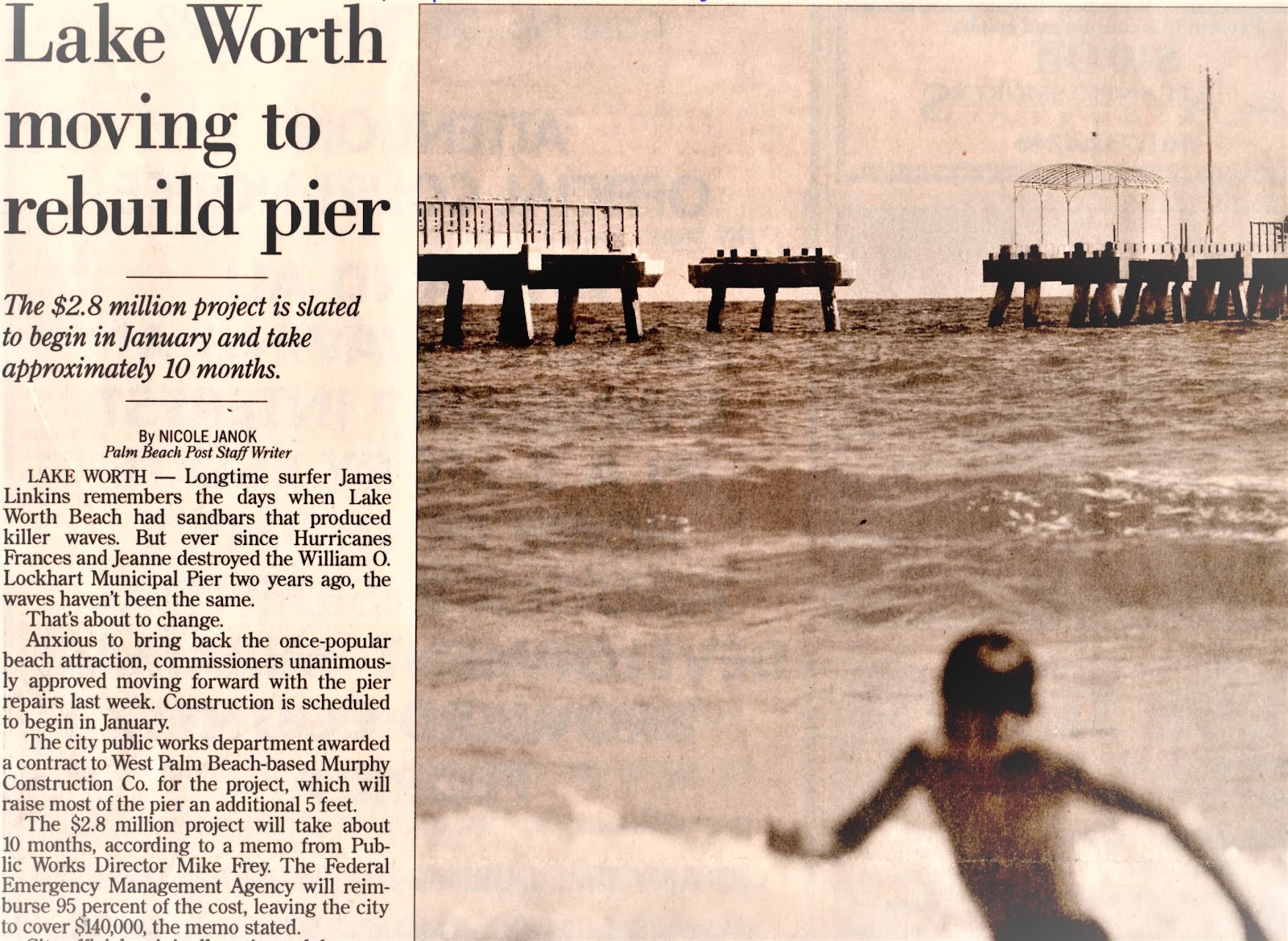A friend of mine heard you speak last month at the Florida Bar "Hot Topics" course in Ft. Lauderdale. He said that you had a lot to say about reverse osmosis. I live in Lake Worth and we are about to embark (again - long story) on a reverse osmosis plant. I have always thought that our answers to the water situation in S. Florida will be solved regionally and not by each individual municipality (there are 38 in Palm Beach County.)
Any light you could shed on this topic would be appreciated.
Thanks for your time.
Wes Blackman, AICP
HI Wes
Long story indeed, and more than just RO issues for Lake Worth. There are two schools of thought on the water supply issue. The first is regional utilities. This works really well for wastewater for two reasons: There is an economy of cost savings with larger facilities. Second, the cost for wastewater disposal is enormous - deep wells at $6 million/well, outfalls that are not permittable, or reuse which potentially contaminates the groundwater and/or negatively impacts rising sea levels, or indirect potable reuse (which requires reverse osmosis - more later). And back-up disposal is always required, so it is hard to do locally. Permit costs are large, and monitoring is significant. But once you have a disposal option chosen, infrastructure it is easily extended.
Water treatment has the same economy of scale issue associated with it, but unless reverse osmosis is pursued, none of the disposal issues. However, what we are seeing in south Florida is that the extraction has become more difficult. Large regional well fields have been disrupted b the SFWMD and are no longer likely to get permitted unless they are indirect potable reuse projects (i.e. you are withdrawing treated wastewater for your raw water supply). Smaller, local well fields remain viable which is where many utilities are looking. The other options - the Floridan is deeper, salty aquifer, but it does not recharge locally, so large withdrawals will likely cause the water to degrade (get saltier) with time. Salty water means reverse osmosis (and a deep well for the concentrate) which is energy intensive. Same with desalination of seawater which is really expensive from a power perspective. All of which means that reverse osmosis is expensive to pursue. Lower pressure systems are better, but...
From a regional perspective, reverse osmosis - one of the SFWMD's options, is expensive. It is a power consumer and FPL will need to increase power capacity to deal with RO plants all over the SE coast. And there will need to be more deep wells. And the water will degrade, which means higher pressures, reinvestment in RO, and more power use. Vicious cycle. The SFWMD next option is reuse of wastewater, but to use it for raw waters supplies requires the same RO process, plus retreatment at the water plant. This costs money also, but the water quality will not degrade with time in the aquifer since the aquifer is a water table aquifer and gets a lot of rain. But the costs for the plant and operations remain. Not currently on the power grid. And to recharge the aquifer you need land, and must not flood property owners, which means that low lying areas cannot pursue this options. Coastal areas cannot either for flooding reasons. And if sea level rises, there will be no place to store the excess either. Reuse long term does not work in the coastal areas. My presentation suggested that the SFWMD look at regional RO plants to recharge the Everglades which is also the recharge area for the Biscayne aquifer (lower zone). That would solve a regional problem, and while energy costs would increase, there might be some economy of scale that would help out with costs. IT also would put water into the Everglades which will be needed for sea level and water quality purposes over the long term (50-100 years). The SFWMD is not interested in seriously evaluating this option. So that brings us back to local issues for water supply.
Lake Worth has the issue that the SFWMD wants to shut down your Biscayne water supplies (their third option), and make you buy water form someone else. That option is limited to buying water from the County. That satisfies one of the SFWMD goals to regionalize, but the County is then burdened with the responsibility to get more water, which means they now do the RO plant and wells, since they will not be able to draw more Biscayne water either. So the issue with water is that regionally the issue of water supply just gets transferred from utility to utility, not solved. Someone has to make the investments in the new wells and new plant (or expand existing ones if they can).
Lake Worth was in a very positive position with its proposed RO plant when you were trying to permit the outfall for disposal of concentrate (vs. the $6 million deep well). Note I was involved with that at the end for the City. That option made sense since your flows are so small and the infrastructure was in place (no permits for digging through the reefs), but a complete lack of wanting to understand how the outfall worked physically just overrode the City's goals, which creates a much bigger problem for the City. If the City were to buy water from the County, the reason would be to save money. The County will recoup the cost of capital (plant + wells + disposal). They also will have added operating costs they will pass on to the City. So, the City would only save money on their side if they can cut costs - which means power, chemicals and staff. Therefore it would not save a lot of money unless the City did away with the existing treatment plant all together, since you cannot decrease staffing at the plant (operator staffing requirements by law). So the City needs to ask - do we want to be in the water business?
What this points out is that where there is investment in infrastructure, the issue is less clear. Existing utilities are examples. Where there is no water plant, regional solutions work a lot better since there is not invested cost and more regional decisions can be made, with those costs passed directly to the consumers.
What this points out is that where there is investment in infrastructure, the issue is less clear. Existing utilities are examples. Where there is no water plant, regional solutions work a lot better since there is not invested cost and more regional decisions can be made, with those costs passed directly to the consumers.
Does that help?
Fred
Yes, it helps. However, Lake Worth is now in a position where the majority of the commission wants to back out of the water deal with the County and has already reneged on a $6 million promised payment that was part of the agreement. We are now pursuing a smaller RO plant than the one originally proposed, which would rely ultimately on permitting of deep well injection. A question mark - much like the situation we were in with the existing ocean outfall. There is now a two to three or more year gap between having the water supply we need and the RO plant coming on line. The Commission is talking about hooking into the West Palm Beach water supply - which is also under restrictions and a court order regarding water quality. The Commission thinks that it could tap into it or the County system on an "emergency basis" - which could be up to two years, a few months at a time. Given that we have want to back out of the contract before the ink is really dry, the County is not going to want to help us even on an emergency basis. We are also asking for forbearances from the County on other matters. SFWMD has changed the way they measure our use of water to average monthly from average yearly. There could be some months and periods when there is nothing - period. The Commission's answer is conservation measures (extreme) and rain barrels.
I am attaching an op-ed piece (click title for link) I did for the Lake Worth Herald around the time when the first RO plant bit the dust. You can tell I am an urban planner and not an engineer, but all along I thought that the initial RO plant, like you, was the best idea.
Fred
Yes, it helps. However, Lake Worth is now in a position where the majority of the commission wants to back out of the water deal with the County and has already reneged on a $6 million promised payment that was part of the agreement. We are now pursuing a smaller RO plant than the one originally proposed, which would rely ultimately on permitting of deep well injection. A question mark - much like the situation we were in with the existing ocean outfall. There is now a two to three or more year gap between having the water supply we need and the RO plant coming on line. The Commission is talking about hooking into the West Palm Beach water supply - which is also under restrictions and a court order regarding water quality. The Commission thinks that it could tap into it or the County system on an "emergency basis" - which could be up to two years, a few months at a time. Given that we have want to back out of the contract before the ink is really dry, the County is not going to want to help us even on an emergency basis. We are also asking for forbearances from the County on other matters. SFWMD has changed the way they measure our use of water to average monthly from average yearly. There could be some months and periods when there is nothing - period. The Commission's answer is conservation measures (extreme) and rain barrels.
I am attaching an op-ed piece (click title for link) I did for the Lake Worth Herald around the time when the first RO plant bit the dust. You can tell I am an urban planner and not an engineer, but all along I thought that the initial RO plant, like you, was the best idea.
Hi Wes
A deep well is $6 milllion - negotiate a price with Youngquist Bros in Fort Myers to drill it(the only driller in the State that has been successful at this - it's waht they do. They have no failures - 88-0). DO NOT BID IT like Key LArgo tried to do and after 6 months, they ended up with Youngquist and a higher price than they could have negotiated.
A deep well should be pretty straightforward to permit. There are dozens of them in SE Florida and only one known issue - which was a problem creatd during construction. They do not leak like the wells in Pinellas Co do and the movement appears to go westward, not toward the ocean. The injection zone is 3000 ft below the surface and both the UM and EPA risk assessments both determined that deep wells posed less risk to people as a disposal option than outfalls (which were a close second) and surface discharges. Note I was a major part of the UM study and provided most ot fhte data for the EPA study). Reuse would likely be the riskiest but it was not included. There is peer reviewed work and real experts to support this position.
Fred





